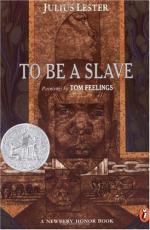
|
| Name: _________________________ | Period: ___________________ |
This test consists of 15 multiple choice questions and 5 short answer questions.
Multiple Choice Questions
1. What was the weigh-in time?
(a) Slaves had to have themselves weighed at the end of each day in case they were getting too much to eat.
(b) Slaves had to have their baskets full of cotton weighed at the end of each day.
(c) Slaves had to help their masters weigh the items they owned because each slave was allowed only a certain weight limit for personal objects.
(d) Slaves had to have their baskets full of crop weighed at the end of each day to ensure they were doing their work.
2. Many of the white men and black slave children had what sort of unique bond, though not always acknowledged?
(a) Father and slave.
(b) Master and servant.
(c) Master and slave.
(d) Father and son/daughter.
3. What was the second group of people that the colonists tried to use for manual labor?
(a) Rich whites.
(b) Poor whites, prisoners, and debtors.
(c) Africans.
(d) Indians.
4. How did Frank Cooper realize his Mammy used to be a slave?
(a) He found her freedom papers.
(b) He saw the old scars on her back.
(c) He saw the cuts on her legs.
(d) He saw how rough her hands were.
5. Who told the account of a man named Gabe?
(a) Ida Hutchinson.
(b) Alice Johnson.
(c) West Turner.
(d) Henry Johnson.
6. What is one way early slave trades were carried out?
(a) Slave traders tranquilized Africans, then captured them.
(b) Slave traders asked the Africans to visit their ship then captured them.
(c) Slave traders would drug Africans and steal them.
(d) The slave traders would lie in wait for the Africans then capture them.
7. In southern society, a man's status was based upon:
(a) The number of slaves he had.
(b) The amount of money he recieved from selling slaves.
(c) The number of slave women he had.
(d) The amount of money he had.
8. Approximately how many Africans were taken from their continent during the years of slave trade?
(a) Fifty million.
(b) Fifty billion.
(c) Ten million.
(d) Ten billion.
9. What was the main plant that was in need of constant care by the slaves?
(a) Rice.
(b) Wheat.
(c) Cotton.
(d) Corn.
10. The job of a slaver trader was to sell the slave to the _____________.
(a) Most respected bidder.
(b) Kindest master.
(c) Cruelest master.
(d) Highest bidder.
11. A buck position consisted of all of the following except....
(a) Hands being tied together at the shins.
(b) Face being stuck in the ground.
(c) A stick held between the arms and knees.
(d) Squatting naked on the ground.
12. Whose account is an example of a joyous occasion seen at the auction block?
(a) Lou Smith.
(b) Jenny Proctor.
(c) Prince Bee.
(d) Doc Daniel Dowdy.
13. Mammy referred to her slave days as what?
(a) The "weary days."
(b) The "hell days."
(c) The "scornful days."
(d) The "misery days."
14. Whose account supports the author's claim that slave traders often used tricks to make the slaves appear well-groomed and healthy for the day of the auction?
(a) Jenny Proctor.
(b) Annonymous.
(c) Henson.
(d) Delicia Patterson.
15. What was Henry Johnson's account about slavery?
(a) He was a driver who was lenient with the whip.
(b) He and other slaves were forced by their master to steal cattle from other slave owners.
(c) He was thrown in a buck and whipped.
(d) His grandmother whipped him to show him what being a slave felt like.
Short Answer Questions
1. This second group of people were not slaves but rather called __________________.
2. What was the typical work hours for a slave who worked in the field?
3. What was the main lesson that Byrl Anderson learned from his Master?
4. What was 'Ol Gabe known for?
5. From where did the first American-built slave ship sail from?
|
This section contains 704 words (approx. 3 pages at 300 words per page) |

|




